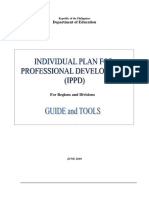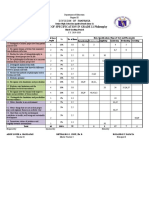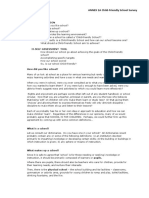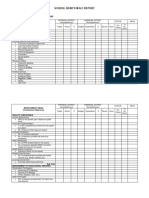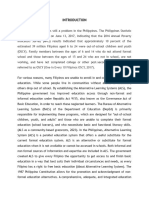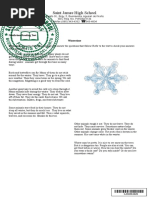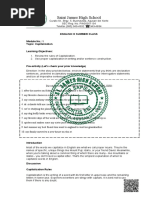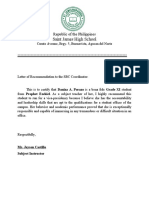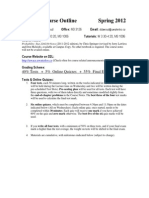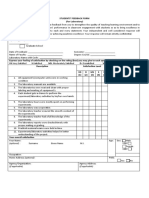ALS-EST Handbook Chapter04 PDF
ALS-EST Handbook Chapter04 PDF
Uploaded by
Jayson CastilloCopyright:
Available Formats
ALS-EST Handbook Chapter04 PDF
ALS-EST Handbook Chapter04 PDF
Uploaded by
Jayson CastilloOriginal Title
Copyright
Available Formats
Share this document
Did you find this document useful?
Is this content inappropriate?
Copyright:
Available Formats
ALS-EST Handbook Chapter04 PDF
ALS-EST Handbook Chapter04 PDF
Uploaded by
Jayson CastilloCopyright:
Available Formats
CURRICULUM
ALS-EST Handbook for Implementers 31
Curriculum
T he ALS-EST Curriculum is a combination of the ALS K to 12 Curriculum and the
TVL Track component of the formal SHS Curriculum.
The ALS K to 12 Curriculum currently covers only up to JHS. However, an ALS
Curriculum for SHS is under development, and its latest draft version includes
a TVL Track, where the learner chooses a specialized skill and undergoes work/
industry immersion. This is compatible with what ALS-EST implements.
ALS-EST, therefore, expects a smooth transition to the forthcoming ALS SHS
Curriculum. While waiting for the ALS SHS Curriculum, ALS-EST will pilot a SHS
equivalent, using the formal Senior High School Technical Vocational (SHS TVL)
track curriculum delivered through the NFE modality.
ALS K to 12 Curriculum
The ALS K to 12 Curriculum contains a learning continuum of essential skills,
knowledge, attitudes, life skills, learning-to-learn skills, and values desired for ALS
Learners.
Table 4-1 lists the six interrelated learning strands contained in the 2018 ALS K to
12 Curriculum. ALS-EST Learners and completers are expected to demonstrate
learning of competencies from each of the six learning strands.
• Each learning strand provides content standards.
These are statements of the core content in terms of knowledge or skill that
students should learn and understand.
• Under each content standard are a number of performance standards.
These are the work that a learner is expected to be able to do.
These demonstrate the achievement, acquisition, and application of the
knowledge or skill required by the content standard.
• Comprising performance standards are learning competencies.
These are more specific applied knowledge, skills, and values that indicate
or validate learning consistent with the broader content and performance
standards.
The curriculum indicates to what ALS level the learning competency is
applicable.
32 ALS-EST Handbook for Implementers
Curriculum
Table 4-1. ALS K to 12 Basic Education Curriculum Learning Strands,
Summary of Objectives and Coverage
Learning Strand 1
Communication Skills (English)
The main thrust of Learning Strand 1: Communication Skills is to develop the ability to access,
critically process, and effectively use available information in a variety of media to be able to:
1. function effectively as a member of the family, community, nation, and the world
2. participate actively in community and economic development.
Learning Strand 1 involves the five macro skills: (1) listening purposively and critically; (2)
speaking clearly and appropriately; (3) reading to process and critically use information from
a wide range of written materials and other forms of media; (4) expressing one’s ideas and
feelings clearly and effectively in writing; and (5) viewing as an ability to demonstrate critical
understanding and interpretation of visual media.
Communication Skills (Filipino)
Kasanayan sa Komunikasyong Filipino
Ang pangunahing layunin ay mapaunlad ang kakayahan ng mga matatatanda at kabataang
hindi na nakapag-aral upang kritikal na masuri, maabot at epektibong magamit ang
impormasyon sa pamamagitan ng iba’t ibang uri ng midya upang:
1. epektibong magampanan ang tungkulin bilang miyembro ng pamilya, komunidad, bansa at
daigdig
2. aktibong makilahok sa pagpapaunlad ng komunidad at ekonomiya.
Kasangkot din dito ang limang makrong kasanayan: (1) kritikal at malayuning pakikinig; (2)
wasto, angkop at malinaw na pagsasalita; (3) pagpoproseso mula sa pagbabasa at masusing
paggamit ng impormasyong nakasulat o inihayag gamit ang iba’t ibang anyo ng midya; (4)
pagpapahayag ng naiisip at nararamdaman nang malinaw at epektibo sa pamamagitan ng
pagsusulat; at (5) kritikal na pag-unawa at pagpapakahulugan sa panonood ng mga midyang
biswal.
ALS-EST Handbook for Implementers 33
Curriculum
Learning Strand 2: Scientific Literacy and Critical Thinking/
Learning Strand 3: Mathematical and Problem-Solving Skills
Learning Strands 2 and 3 are intended to develop skills which include the core competencies
of scientific literacy and numeracy. Integrated across scientific and numeracy literacy skills
are the critical functional competencies of openness to change, awareness of options, ability
to make critical and informed decisions, curiosity, innovativeness and creativity, scientific
thinking, logical reasoning, spatial intelligence, and future orientation. These competencies
specifically seek to extend and refine learners’ critical and creative thinking processes including
the abilities to:
1. organize new knowledge
2. gather and analyze information
3. categorize things and ideas
4. make comparisons
5. infer principles from evidences
6. critique one’s own thinking
7. evaluate options as a basis of decision making
8. apply the scientific process
9. seek explanation for applying the scientific process
10. support assertions with evidences
11. overcome obstacles and find a better way to do things
12. apply principles to draw conclusions
13. learn independently
The ultimate goal of Learning Strands 2 and 3 is to develop individuals who are aware of their
own thinking, able to make critical and informed decisions, defend their ideas and evaluate the
ideas of others and are persistent in striving for new ways of solving problems. Through the
development of such critical thinking and problem-solving skills, ALS learners will enhance
their own personal and social effectiveness as a pathway to improve quality of life.
Learning Strand 4: Life and Career Skills
Learning Strand 4 focuses on the attitudes, skills, and knowledge (competencies) necessary
for earning a living and promoting a sustainable lifestyle.
This learning strand covers the ability to earn a living–through employment/self-employment,
entrepreneurship, sustainable consumption–live within one’s means, navigate the market place
(as both consumer and seller), reduce wasteful expenditure and perform wise consumption/
utilization of resources, conserve resources for future generations, and produce and use
work-related skills, knowledge, values, and technology to maximize one’s efficiency and
performance as a productive citizen.
In addition to demonstrating mastery of skills completed under Learning Strand 4, all ALS
learners are encouraged to complete at least one TVL track specialization leading to the
acquisition of occupational skills and a NC. Learners are referred to the list of specializations in
formal school’s TVL Track.
34 ALS-EST Handbook for Implementers
Curriculum
Learning Strand 5: Understanding Self and Society
Learning Strand 5 is intended to help learners acquire a positive sense of self and social
responsibility that will lead them to develop their potentials and enable them to live together
harmoniously within the contexts of their family, local community, and country as well as
participate as a member of the Association of Southeast Asian Nations (ASEAN) region and an
increasingly global community.
In an increasingly globalized world, it is important that learners are able to see things through
the hearts, minds, and eyes of others and understand the impact of regional and global issues
on their lives and the lives of the members of their family, community, and country.
The learning strand endeavors to encourage learners to continue developing the knowledge,
attitudes, values, and skills in order to act locally in building a just, peaceful, equitable,
compassionate, multi-cultural, and pluralistic society. Hence, it is important to articulate in
the minds of the learners that whatever they do affects their sphere of influence (family and
community) and creates an impact on the nation, the region, and the world. Thus, as members
of the ASEAN and world communities, learners’ horizons for developing identity need to be
national, regional, and global.
Learning Strand 6: Digital Citizenship
This learning strand seeks to help equip ALS learners with critical knowledge, skills, and values
to be able to live and work effectively as part of the digital universe.
To achieve digital literacy, ALS learners need both Information and Communication
Technologies (ICT)-related knowledge and skills and the ability to integrate such skills and
knowledge across the competencies listed in the other four learning strands of the ALS
curriculum. This is the application part where the learners use their digital knowledge and skills
as tools to communicate with others and solve problems in daily life. Each of the other four
learning strands will thus go hand in hand with Learning Strand 6.
This Learning Strand covers the following digital citizenship competencies:
1. Digital Concepts
2. Digital Operations and Management
3. Digital Applications
4. Digital Systems Network
5. Digital Devices
6. Digital Ethics
Source: Omnibus Policy on K to 12 (Forthcoming)
ALS-EST Handbook for Implementers 35
Curriculum
Alignment to Formal K to 12
Table 4-2 provides the alignment of the ALS K to 12 Curriculum with the grade
levels of the formal school system.
• The ALS K to 12 is aligned but is not a mirror image of the formal K to 12
Enhanced Curriculum for Basic Ed.
It does not have all the competencies of the formal school curriculum.
ALS K to 12 curriculum adds competencies not found in the formal school
system:
– Digital citizenship skills
– Global citizenship skills
– Learning-to-learn skills
– Life skills-related competencies
Table 4-2. Alignment of ALS K to 12
Curriculum with Formal K to 12
K to 12 Enhanced
ALS K to 12 Levels Basic Education Levels
Elementary
Basic Literacy Kindergarten to Grade 1
Lower Elementary Grades 2 to 3
Advanced Elementary Grades 4 to 6
Secondary
Junior High School Grades 7 to 10
Senior High School Grade 11 to 12
Learner-Centered, Community-Responsive Implementation
ALS-EST caters to a special subset of learners who have different capacities and
needs. For the Program to be relevant for them, and to increase the likelihood that
they will complete the Program, the curriculum has to be responsive to learners’
needs and expectations.
In the implementation of the ALS K to 12 Curriculum, it is essential that teachers
focus on the everyday application of competencies. This shall also guide the
development of appropriate, relevant, and responsive learning materials and
learning assessment tools.
36 ALS-EST Handbook for Implementers
Curriculum
ALS-EST teachers are encouraged to make learning more meaningful and
resonant to adult learners by contextualizing the education competencies. This
can be done by:
• Building on learners’ existing knowledge and experience
• Respecting and incorporating local knowledge and community wisdom
• Responding to specific learner needs and potentials
The level of learners’ prior learning will be assessed with results used as
basis for identifying learning gaps/needs.
Learners’ performance across learning strands will be monitored and
documented throughout the Program. At the point of exit, their level of
competence will be assessed and certified.
• The Program respects learners, particularly adult learners, who may not be
interested in full equivalency certification, but want to strengthen specific
basic ed competencies or improve their overall life skills.
In such cases, the ALS teachers will customize learning programs around needed
competencies based on the ALS K to 12 Curriculum while ensuring integration
with the skills training component. These functional literacy type programs might
be shorter than a regular ALS-EST equivalency program.
Skills Training Curriculum
Technical Skills development is seen as an essential component of economic
growth. In its meeting in Washington DC in April 2010, the G20 Employment
and Labor Ministers recommended to prioritize education, lifelong learning, job
training, and skills development strategies. They also specified the following
critical elements (ILO, 2010):
• Broad availability of quality education as a foundation for future training
• Solid bridges between the world of work and training providers in order to
match skills provision to the needs of enterprise
• Continuous workplace training and lifelong learning
• Anticipating and building competencies for future needs
• Ensuring broad access to training opportunities for all
The ALS-EST program agrees with these critical elements, and seeks to promote
the full integration of the ALS K to 12 Curriculum and the SHS TVL Track wherever
appropriate and relevant.
ALS-EST Handbook for Implementers 37
Curriculum
Most of the 98 pilot ALS-EST schools implement skills training curricula anchored
on the national technical training standards of TESDA. Table 4-3 lists some of
these technical skills and subskills training.
Table 4-3. Examples of Technical Skills and Subskills Training Offered by TESDA
Skills Subskills Skills Subskills
Food and Food and Beverage Wellness Hairdressing
Housekeeping Cookery Nail Care
Food Processing Wellness Massage
Baking and Pastry Beauty Care
Production
Dressmaking Tailoring
Housekeeping
Dressmaking
Electronics Electrical Installation and
Garments and Textile
and Welding Maintenance
Fashion Design
Computer System
Servicing Agriculture Organic Vegetables
Automotive Organic Agriculture
Shielded Metal Arc Welding Agricrop Production
Electronics Production and Carpentry Plumbing
Assembly Carpentry
Furniture and Cabinet
Making
Technical Drafting
Skills Training Offerings
Demand and supply factors influence the choice of skills training offered by the
pilot schools. Whether a skill qualifies for TESDA NC also matters.
A careful consideration of these demand and supply factors should constitute the
basis for generating a list of priority skills training that may be offered through the
ALS-EST program.
• ALS-EST schools need to consider the available resources in the host school
and community to determine the supply side.
For example, schools need to take stock of the availability of the following:
Skill trainers/assessors
Materials
Workshops
Equipment
38 ALS-EST Handbook for Implementers
Curriculum
• On the demand side, schools need to align their skills training offerings to the
preferrences of target learners, and the human resource requirements of the
community.
Aligning skills training with job market demands helps to increase the
likelihood of employment for ALS-EST graduates, and avoid skills-employ-
ment mismatch.
The schools need to conduct market analysis to identify skill areas with high
demand in the labor market. This requires consulting with key stakeholders,
such as TESDA, Department of Trade and Industry (DTI), Department of Labor
and Employment (DOLE), LGUs, private employers/Chambers of Commerce
and skills training providers among others.
• Schools and implementers may adopt the Standard Needs Assessment
Survey tools, currently used by TESDA to come up with a systematic list of
demand-driven skills that could be offered through ALS-EST.
Identified learners will be matched, as far as practicable, with the most
compatible skills training offering, taking into consideration proficiency
assessments, inclination or interest of the learners, and counselling. The
results of the learners needs assessment are analyzed against the results of
the labor market analysis, and the availability of resources.
Skills Training Content
Skills Training shall follow TESDA TR or approved non-TESDA Training Programs.
• A TR “serves as basis for which the competency-based curriculum and
instructional materials and competency assessment tools are developed,”
and “defines the competency standards for a national qualification and how
such qualification can be gained, assessed, and be given recognition.”
A TR specifies the training arrangements, including: curriculum design,
training delivery, entry requirements, list of tools, equipment and materials,
training facilities, trainer’s qualification, and institutional assessment.
The TESDA website lists almost 300 downloadable TRs, covering skills
eligible for varying levels of qualification.
• Schools can also offer non-TESDA Training Programs, subject to approval of
the ALS-EST Project Management Team at the Division level.
ALS-EST Handbook for Implementers 39
Curriculum
Box 4-1. A Sample Training Syllabus for Baking Technology
The syllabus outlines the fundamentals of and technical know-how in baking. It incorporates
different baking methods and procedures undertaken in a workshop setting to enhance the
learning process.
Course Objective: The intensive course aims to develop and produce well-rounded skilled
bakers equipped with updated baking knowledge and techniques.
Duration: The program lasts two quarters or a total of 50 weeks (five days a week). Weeks 1
to 20 are for academic in-school training while Weeks 21 to 50 are for on-the-job training.
Training Plan: The table below shows a segment of the skills training plan on Baking
Technology. Values education is a mandatory component of skills training.
Table 4-4. Training Plan: Baking Technology
Week Competencies Training Skills
1 • Workplace communication • Effective communication (oral and
• Working in a team written)
• Career Professionalism • Industry policies and practices
• Desirable work attitudes and values
2 • Occupational safety and • Occupational health & safety
maintenance procedures, practices, and
• Baking Terminologies 1 regulations
• Baking terminology comprehension
3 • Baking Terminologies 2 • Baking terminology comprehenison
• Ingredients and their functions (continued)
• Identifying different baking ingredients
and their functions
Week Focus Skills Sub-skills
17 • Pies and pastries • Choux pastry • Cream puffs
production • Perfecting the crust • Custard pie
• Other baked • Baking the meringue • Pineapple pie
products • Buko pie
• Brazo de Mercedes
18 IN-HOW (Intensive • Inventory and • Breads
Hands-on Workshop) evaluation of skills and • Cakes
Culmination Part 1 competencies
• Practice acquired skills
19 IN-HOW Culmination • Cookies
Part 2 • Pies and pastries
Source: Tuloy sa Don Bosco Foundation
40 ALS-EST Handbook for Implementers
Curriculum
This includes among others: skills training designed by national government
agencies (NGAs) (for example, Agricultural Training Institute, Philippine
Carabao Center, Department of Tourism), training programs developed by
industry or private training institutions.
Box 4-1 gives an example of a Training Syllabus developed and used by a
private tech-voc school.
Skills training should incorporate relevant Core Competencies of the ALS
Elementary and Secondary curriculum as may be necessary for the development
of certain skills. For example, measurement for carpentry, or weights and measures
for baking.
Schools should be guided by the results of the recognition of prior learning
(RPL) assessment of learners to guide them in the selection and design of the
skills training content. Some learners may have acquired specific skills prior to their
enlistment to ALS-EST, and schools should be able to build on those.
The length of the skills training depends on its design, as outlined in the TR
or the approved training program, and the specific needs of learners and the
community. It is possible for schools to have comprehensive trainings that last for
several months, and also have shorter duration trainings with specific focus.
The schools will devise appropriate schedules for the education component and
the skills training component of the Program. As an implementation strategy,
many ALS-EST schools offer the education component on weekdays, and the
hands-on vocational skills training on weekends.
Integrating Education and Skills Training Competencies
ALS-EST aims to maximize opportunities for curriculum integration. This involves:
• Integration of competencies across the six learning strands
• Integration of ALS education and skills training competencies
Integration will make the skills training more meaningful as students learn not only
the ‘how’ but also the ‘why’ of doing things. Students learn to be critical of their
own work leading to improved ways of thinking which is an essential requirement
for becoming an empowered and productive member of society.
ALS-EST Handbook for Implementers 41
Curriculum
Aligning these learning competencies require that the ALS teachers and Skills
Trainers work together to do joint mapping, draw up the syllabi together, and
plan the teaching tasks (see Chapter 6, Learning Delivery, and Chapter 7, Learning
Facilitators and Tech-Voc Teachers).
There have been efforts by ALS-EST schools and non-DepEd partners to integrate
skills training with the teaching of education competencies. Box 4-2 and Box 4-3
give examples.
Box 4-2. Curriculum Integration in Inocencio V. Ferrer Memorial School of Fisheries
The school approaches curriculum integration in four steps: mapping, curriculum web,
curriculum brief, and session guide.
• Mapping: Competencies identified in the learning strands specified in the Individual Learning
Agreement (ILA) can be mapped and matched with those required for the skills training.
Table 4-5 shows a sample of mapped competencies.
42 ALS-EST Handbook for Implementers
Curriculum
Table 4-5. Sample of Competencies Map: Food Processing NC II
ALS-EST LEARNING STRANDS SKILLS COMPETENCIES
1. Interpret common written LO3
abbreviation and acronyms Implement Food Sanitation Practices
LS 1 CS/EN-PSC-BL-3 1.1 Workplace Sanitation Regulation in Implementing
Sanitary Food Handling Practices
1.2 Safety Measures to be Observed in Implementing
Sanitary Food Handling Practices
LO3
Perform Post Packaging Procedures
1.1 Method of Labeling
1. Analyze Data from Graphs and LO1
Charts Perform Mathematical Computation
1.1 Summarizing and Tabulating All Raw Data
Gathered
2. Percent and Percentage LO5
LS2 CP/INS-NS-PSB-AE/LE-69 Production Report
1.1 Process Flow Chart of Making Pickled Mixed
Vegetables
1.2 Daily Production Input
1.3 Daily Production Output
1. Ratio and Proportion LO3
LS2 CP/NS-NS-PSB-AE-65 Process Food/Fish by Salting, Curing and Smoking
1.1 Prepare Salting, Curing Solutions and Mixture (
Measuring and Weighing required salt for salting,
curing and smoking)
2. Scientific Methods of Food LO4
Preservation Cook Sugar Concentrates
LS2 SC-AS-PSB-BL/LE/AE/ 1.1 Cook Jam, Jellies, Marmalade and Preserves
LS-1.2.1 LO3
Process Foods by Fermentation and Pickling (Fruits
and Vegetables)
1.1 Perform Alcoholic Fermentation
1.2 Perform Acetic Acid Fermentation
1.3 Perform Lactic Acid Fermentation
LO3
Process Fish and Other Fishery Products by
Fermentation and Pickling
1.1 Prepare Salting and Curing Solution and Mixturing
1. Reduce Wastage of Resources LO4
at Home and Work A. Render Safety Measures
1.1 Safety Measures to be applied to work place
rules and regulations
2. Proper Ways of Caring for and LO5
Conserving the Environment B. Implement Housekeeping Activities
S2 SC-AS-PSB-LE/AE/LS/AS19.28 1.1 Waste Management
ALS-EST Handbook for Implementers 43
Curriculum
ALS-EST LEARNING STRANDS SKILLS COMPETENCIES
3. Prepare a Plan for Setting Up a LO5
Small Business Production Report
LS4 LC-AE-RSB-LE/AE/LS/ 1.1 Procedure for Determining the Selling Price of
AS-8.1 Processed Products
1.2 Financial Recording
4. Understand Work Related LO2
Health Observe Personal Hygiene and Good Grooming
LS2SC-AS-PSB-BL/LE/AE/LS/ 1.1 Measure to consider in Practicing Personal
AS-1.4.3 Hygiene and Good Grooming
LO3
Implement Food Sanitation
1.1 Food Safety
Source: IVFMSF (n.d.)
• Curriculum Web: From the identified competencies for both basic ed and skills training,
a central theme or a binding project/performance may be utilized to connect these
competencies together. Figure 4-1 shows a sample curriculum web.
Figure 4-1. Sample Curriculum Web: ALS Competencies and Skills Competencies
Percent
and
Percentage
LS-ZCP/NS PSB AE/L5 72
LO 5
PRODUCTION
REPORT
LO 2
PERFORM
Analyze MATHEMATICAL;
Data from Graphs COMPUTATION
and Charts 1.1 Summarize and
Tabulating All Data
Source: IVFMSF (n.d.)
• Curriculum Brief: This is a comprehensive documentation of the integrated curriculum,
which specifies the ALS and Skills Competencies, as well as the Teaching-Learning
Strategies.
• Session Guide: From the curriculum brief, facilitators/trainers may proceed with
developing a session guide. The session guide lays out the activities to be done for a
specific session. Table 4-6 gives an example.
44 ALS-EST Handbook for Implementers
Curriculum
Table 4-6. Sample Session Guide: Food Processing NC II (Excerpts)
Learning Objectives1
1.1 Textual Form
1.2 Tabular and Graphical Form
1.3 Flow Chart of making Salted Egg
Key Learning Points Methodology/Activities
Summarizing and Tabulating all Raw Introduction:
Data Gathered Ensure that the room was arranged based on the design
Any set of information or data grouping and all conditions are observed.
collected for study should DO: Greet the learners and make them comfortable.
be organized and analyzed Unlocking Difficulties (Matching Type)
systematically for easier and faster Duration: 10 minutes
interpretation. To do this, collected
data may be presented in any of the Direction:
following forms: Write the correct answer in column A from its corresponding
1. The textual forms are used when answer to column B.
data to be presented are few. Duration:10 minutes
2. The tabular and graphical forms A B
are used when more detailed
_____1. To count, record a. Production Report
information is to be presented
or list systematically
Using tables and graphs has the _____2. A collection of b. Tabulate
following advantages: information about
a study under c. Data
1. Data is presented in more
practical and convenient way. investigation
_____3. The process of d. Recording
Instead of writing text on the
information gathered, items can capturing data
e. Solution
be enumerated in tabular form or or translating
shown in graphical form information to a f. Cost
recorded format
2. Data can be compared more stored on a storage
easily medium often
Recording tables and graphs can referred to as ‘record’
be done more easily because the _____4. A homogenous
needed information can be seen mixture of substance
at a glance. with variable
composition
3. Data can be analyzed
_____5. A written record
comparatively
showing the input-
Tables and graphs enable a output relationship
thorough analysis of data because in determining the
all needed information is clearly yield from a certain
known. procedure
MOTIVATION: FOUR PICS ONE WORD
(slides presentation)
Duration: 15 minutes
The trainer will present several slides. The trainees will
guess what word is being used to describe the picture in the
presentation.
Source: IVFMSF (n.d.)
ALS-EST Handbook for Implementers 45
Curriculum
Box 4-3. Curriculum Integration in Silliman University
Siliman University is a private research university based in Dumaguete City. It is developing an
ALS-EST program that covers the following skills: para-teaching, assistant librarianship, sports
coaching and officiating, and information and communications technology. Siliman University took
the following steps to integrate the education and skills training curriculum for the Program:
• Reviewed the content, performance standards, and competencies for the six ALS learning
strands
• Specified the competencies required for the intended ALS-EST programs
• Took into account the needed competencies for skills training vis-a-vis TESDA handbook, tertiary
syllabuses, coaching manuals, and other reference materials
• Mapped the content and performance standards as well as competencies for each of the
programs based on the Basic Education Enhanced K to 12 Curriculum Program, the updated
ALS learning strands, baccalaureate course competencies, TESDA competencies, and
competencies indicated in training manuals
• Finalized the time allocation for each program and the actual time allocation needed for each unit/
skill to be covered
• Did a breakdown of coverage or processes needed to achieve the standards/competencies and
skills in every program, using an agreed format
• Derived the meaning of the learning goals of the knowledge that need to be acquired and
transferred them to each of the lessons and units in the specific program
• Specified the key ideas and essential questions for each of the units in each of the programs,
including teaching and learning strategies/activities, assessments (diagnostic, formative and
summative), journal writing for portfolio assessment, and other materials and resources needed
• Identified the core values to be integrated, according to DepEd’s and the University’s Vision,
Mission and Goals
• Established the alignment of content and learning progression within and across programs
• Completed the articulated and integrated curriculum maps for the programs
• Modules for each of the programs will be designed based on the curriculum maps
Source: Silliman University
References
• DEPARTMENT OF EDUCATION. Omnibus K to 12 Policy. Forthcoming.
• INTERNATIONAL LABOUR ORGANIZATION. A Skilled Workforce for
Strong, Sustainable and Balanced Growth. 2010.
• INOCENCIO V. FERRER MEMORIAL SCHOOL OF FISHERIES. A Journey
of IVFMSF ALS-EST Towards Curriculum Integration: An Innovation
(PowerPoint Presentation). n.d.
• SILLIMAN UNIVERSITY. Presentation on Curriculum Integration for ALS-
EST. Unpublished.
• TECHNICAL EDUCATON AND SKILLS DEVELOPMENT AUTHORITY.
Training Regulations. Retrieved June 2018. Available at www.tesda.gov.ph/
Download/Training_Regulations
• TULOY SA DON BOSCO FOUNDATION INC. Training Syllabus for Baking
Technology. Unpublished.
46 ALS-EST Handbook for Implementers
You might also like
- Advancing Basic Education in The Philippines: Grade 3 Full Refresher Learners Batch With 2 LearnersDocument12 pagesAdvancing Basic Education in The Philippines: Grade 3 Full Refresher Learners Batch With 2 LearnersLovely Lleonore LimNo ratings yet
- A Closer Look at The Teachers and The Teaching Profession in The Asean and BeyondDocument15 pagesA Closer Look at The Teachers and The Teaching Profession in The Asean and BeyondErica Vailosis83% (18)
- Advanced Human Growth and DevelopmentDocument6 pagesAdvanced Human Growth and DevelopmentSilvy AmaliaNo ratings yet
- Reading and Writing First ExamDocument2 pagesReading and Writing First ExamJayson Castillo75% (4)
- Cooperative Learning Lesson Plan Edu 220Document1 pageCooperative Learning Lesson Plan Edu 220api-354631207No ratings yet
- The Plight of Our ALS Completers After CompletionDocument3 pagesThe Plight of Our ALS Completers After CompletionAileen Sia100% (1)
- The New Curriculum For ALSDocument101 pagesThe New Curriculum For ALSGrover DejucosNo ratings yet
- For Grade 4-6 - Psychosocial DLL (August 22-26, 2022)Document7 pagesFor Grade 4-6 - Psychosocial DLL (August 22-26, 2022)Myka Andrea GarciaNo ratings yet
- ALS-EST Handbook Chapter11Document12 pagesALS-EST Handbook Chapter11MariNo ratings yet
- Als CurriculumDocument28 pagesAls CurriculumMaricel Loderico100% (1)
- ALS SHS Policy UpdatesDocument9 pagesALS SHS Policy Updatesminda abriganaNo ratings yet
- Ipcrf Modified DevelopmentalDocument3 pagesIpcrf Modified DevelopmentalPrincess Mae AlmariegoNo ratings yet
- Grade 5 PPT Nevrous SystemDocument44 pagesGrade 5 PPT Nevrous SystemshamshadNo ratings yet
- Department of Education: Republic of The PhilippinesDocument45 pagesDepartment of Education: Republic of The PhilippinesMATHEW ANGELO GAMBOANo ratings yet
- How To Access The Matatag Education PortalDocument72 pagesHow To Access The Matatag Education PortalanewflorescaNo ratings yet
- Report On The Modular Distance Learning Feedback Mechanism of Paratong Es SY 2020-2021Document2 pagesReport On The Modular Distance Learning Feedback Mechanism of Paratong Es SY 2020-2021Lourdes FloriaNo ratings yet
- Department of Education: Republic of The PhilippinesDocument8 pagesDepartment of Education: Republic of The PhilippinesMark Ver Santos San AgustinNo ratings yet
- New Microsoft Word DocumentDocument9 pagesNew Microsoft Word DocumentCecilia Afinidad100% (1)
- Als Bow Ls 5Document9 pagesAls Bow Ls 5Iren Castor MabutinNo ratings yet
- Child-Friendly Schools: Unicef'S Manual OnDocument14 pagesChild-Friendly Schools: Unicef'S Manual OnFaye PanlilioNo ratings yet
- DepEd Grading System For School Year 2022Document4 pagesDepEd Grading System For School Year 2022LEONARD JIM P. DUMADANGONNo ratings yet
- Table of Specification in Grade 11 PhilosophyDocument4 pagesTable of Specification in Grade 11 Philosophyrhem mugolNo ratings yet
- ALS SHS ProspectusDocument4 pagesALS SHS ProspectusOjoy PersiaNo ratings yet
- Department of Education School Improvement Plan (SIP) Output ChecklistDocument10 pagesDepartment of Education School Improvement Plan (SIP) Output ChecklistMervin HangadNo ratings yet
- Alternative Learning System - Docx Hand-OutDocument10 pagesAlternative Learning System - Docx Hand-OutAnonymous r5U1y830% (1)
- SGC Functionality Assessment Tool - CapBuildDocument53 pagesSGC Functionality Assessment Tool - CapBuildRod ReyesNo ratings yet
- Project-Proposal-IGP-Programs MATCH QUIZDocument3 pagesProject-Proposal-IGP-Programs MATCH QUIZarnelNo ratings yet
- School Contingency Plan 2022 2023Document21 pagesSchool Contingency Plan 2022 2023Jesel TanzaNo ratings yet
- Annex 1 NLC Registration FormDocument1 pageAnnex 1 NLC Registration Formrhea diadulaNo ratings yet
- Instructional Supervision Plan 2 2024Document8 pagesInstructional Supervision Plan 2 2024Jerome Tamayo Santiago100% (1)
- SHS SIP ProjectsDocument15 pagesSHS SIP Projectsramier p. jubay jr.100% (1)
- I. Learning Competency:: The Layers of The EarthDocument3 pagesI. Learning Competency:: The Layers of The EarthNica Marie100% (1)
- School Heads Evaluation SheetDocument3 pagesSchool Heads Evaluation SheetBEN BANDOJO100% (1)
- ILMP SampleDocument2 pagesILMP SampleDAVID JONH ACOSTA100% (1)
- This Is An Intent LetterDocument1 pageThis Is An Intent LetterHanifah Edres DalumaNo ratings yet
- Historical, Legal Bases and Policy Guidelines of Alternative Learning SystemDocument8 pagesHistorical, Legal Bases and Policy Guidelines of Alternative Learning SystemPingaping, Maricel B.No ratings yet
- Guidelines For HT PromotionDocument10 pagesGuidelines For HT PromotionCamz MedinaNo ratings yet
- Accomplishment Report FormatDocument3 pagesAccomplishment Report FormatLawrence Gerald Lozada BerayNo ratings yet
- LP Science 7 WK 4 (MAY 2-6)Document5 pagesLP Science 7 WK 4 (MAY 2-6)Joanne Gaviola Godezano100% (1)
- For Inset TopicsDocument18 pagesFor Inset TopicsRonalyn ColladoNo ratings yet
- FIRST QUARTER SLM WALKTHROUGH OBSERVATIONS - REVIEW OF SLMsDocument41 pagesFIRST QUARTER SLM WALKTHROUGH OBSERVATIONS - REVIEW OF SLMsMICHAEL ANORANo ratings yet
- ALternative Learning SystemDocument11 pagesALternative Learning SystemLeonor BagnosNo ratings yet
- Pre-Observation Form 2018-2019Document2 pagesPre-Observation Form 2018-2019api-458245563100% (1)
- SIP Annex 2A - Child-Friendly School SurveyDocument12 pagesSIP Annex 2A - Child-Friendly School Surveydolly kate cagadas100% (1)
- English 4 ApprovedDocument4 pagesEnglish 4 ApprovedChristian jade QuijanoNo ratings yet
- Supreme Student Government (SSG) Oath of OfficeDocument1 pageSupreme Student Government (SSG) Oath of OfficeSHEILA GUTIERREZ100% (1)
- SSG SPG Action Plan TemplateDocument4 pagesSSG SPG Action Plan TemplateChelejean BaticaNo ratings yet
- Management of Resources: Indicator 1Document28 pagesManagement of Resources: Indicator 1Aldrin Dela CruzNo ratings yet
- MELCs Implementation - San Matias National High School SHSDocument15 pagesMELCs Implementation - San Matias National High School SHSOfelia DavidNo ratings yet
- Narrative Accomplishment Report of English Department inDocument2 pagesNarrative Accomplishment Report of English Department inFred Ryan Canoy DeañoNo ratings yet
- Project Proposal: Schools Division of Sorsogon Cocok-Cabitan Elementary SchoolDocument4 pagesProject Proposal: Schools Division of Sorsogon Cocok-Cabitan Elementary SchoolJessa BurgosNo ratings yet
- SBM Monitoring ChecklistDocument16 pagesSBM Monitoring ChecklistGerry MakilanNo ratings yet
- Re-Orientation and Re-Organization of Assignments in School-Based ManagementDocument12 pagesRe-Orientation and Re-Organization of Assignments in School-Based ManagementDONA FE V. MANAGANTANNo ratings yet
- Acr Inset 17Document4 pagesAcr Inset 17Eddah DahanNo ratings yet
- Table of Specification PhiloDocument3 pagesTable of Specification PhiloJinky JaneNo ratings yet
- I Likha 2022 2023Document4 pagesI Likha 2022 2023Nerissa YGNo ratings yet
- Project ProposalDocument5 pagesProject ProposalPortia Sales100% (1)
- Classroom Readiness Checklist 22-23Document2 pagesClassroom Readiness Checklist 22-23Leonisa V. Braganza100% (1)
- School Head'S M & E Report: Table 1-A: Physical Output Tracking Form-SIPDocument3 pagesSchool Head'S M & E Report: Table 1-A: Physical Output Tracking Form-SIPPagkakaisa Ang Kailangan TolNo ratings yet
- RPMS SY 2021-2022: Teacher Reflection Form (TRF)Document7 pagesRPMS SY 2021-2022: Teacher Reflection Form (TRF)Chichay MenorGuimmayen RequiminMaravillaNo ratings yet
- 2023 Study Guide Lesson 1 Graduateness-1Document9 pages2023 Study Guide Lesson 1 Graduateness-1Margaret JobeNo ratings yet
- Research Te 2Document9 pagesResearch Te 2Jhoker SudzNo ratings yet
- Ges New Jhs Syllabus Computing CCP Curriculum b7 b10 Draft ZeroDocument106 pagesGes New Jhs Syllabus Computing CCP Curriculum b7 b10 Draft ZeroBenjamin MacFinn50% (2)
- Peac Sip TemplateDocument40 pagesPeac Sip TemplateJayson Castillo100% (3)
- Nonfiction Reading Test WintertimeDocument4 pagesNonfiction Reading Test WintertimeJayson CastilloNo ratings yet
- Curriculum Map P.E 9Document5 pagesCurriculum Map P.E 9Jayson Castillo0% (1)
- Oral Communication Midterm ExamDocument4 pagesOral Communication Midterm ExamJayson CastilloNo ratings yet
- Intro To PoliticsDocument36 pagesIntro To PoliticsJayson CastilloNo ratings yet
- Summer Class Module 3Document5 pagesSummer Class Module 3Jayson CastilloNo ratings yet
- Summer Class Module 2Document16 pagesSummer Class Module 2Jayson CastilloNo ratings yet
- Letter To Chief of PoliceDocument1 pageLetter To Chief of PoliceJayson CastilloNo ratings yet
- The Executive BranchDocument10 pagesThe Executive BranchJayson CastilloNo ratings yet
- Saint James High School: Republic of The PhilippinesDocument1 pageSaint James High School: Republic of The PhilippinesJayson CastilloNo ratings yet
- Christian Jade Ompoc Grade XIDocument1 pageChristian Jade Ompoc Grade XIJayson CastilloNo ratings yet
- Resume For Job ApplicationDocument3 pagesResume For Job ApplicationJayson CastilloNo ratings yet
- Poster Making Contest Mechanics and CriteriaDocument1 pagePoster Making Contest Mechanics and CriteriaJayson Castillo100% (1)
- English Literature: A Wife of BathDocument32 pagesEnglish Literature: A Wife of BathJayson CastilloNo ratings yet
- Blood Movie ScriptDocument8 pagesBlood Movie ScriptJayson CastilloNo ratings yet
- Unit Lesson Plan 1 - Intro To CommunityDocument6 pagesUnit Lesson Plan 1 - Intro To Communityapi-527767687No ratings yet
- Gen BiogologyDocument6 pagesGen BiogologyCrystel ParNo ratings yet
- Swimming Thesis TopicsDocument8 pagesSwimming Thesis Topicsjuliekwhlanchorage100% (1)
- IGMPI Membership FormDocument3 pagesIGMPI Membership Formshyam dasNo ratings yet
- Eligiblity CriteriaDocument2 pagesEligiblity Criteriamayur_lanjewarNo ratings yet
- Stat 230 Course OutlineDocument3 pagesStat 230 Course OutlineTimothy Hyeunggyu KimNo ratings yet
- 104 Syllabus Fall 2020 Revised Sep 21Document5 pages104 Syllabus Fall 2020 Revised Sep 21EricNakamotoNo ratings yet
- ST Journal EntryDocument47 pagesST Journal EntryMaria loutchie VerdidaNo ratings yet
- Murzban Jal (Editor), Jyoti Bawane (Editor) - Theory and Praxis - Reflections On The Colonization of Knowledge-Routledge India (2020)Document263 pagesMurzban Jal (Editor), Jyoti Bawane (Editor) - Theory and Praxis - Reflections On The Colonization of Knowledge-Routledge India (2020)Vijay JhaNo ratings yet
- 2008 Course Summary Sheet: Master of Advertising (Creative Advertising) (IX96)Document3 pages2008 Course Summary Sheet: Master of Advertising (Creative Advertising) (IX96)Terry FlewNo ratings yet
- Sign Language Translator ThesisDocument6 pagesSign Language Translator ThesisBuyCustomPapersOnlineChicago100% (1)
- Activity Guide and Evaluation Rubric - Unit 3-Task 4 - ESP SyllabusDocument10 pagesActivity Guide and Evaluation Rubric - Unit 3-Task 4 - ESP SyllabusCarlos ZambranoNo ratings yet
- Project Prop With Action PlanDocument6 pagesProject Prop With Action PlanAnonymous f1Dn9aNo ratings yet
- Action Plan For MTDocument15 pagesAction Plan For MTCACHOLA RAMOSNo ratings yet
- Chinese Education SystemDocument20 pagesChinese Education SystemJesse100% (1)
- MCE DatasheetDocument2 pagesMCE DatasheetH Awad MahgoubNo ratings yet
- Students Feedback Form LaboratoryDocument2 pagesStudents Feedback Form LaboratoryRonald Candy LasatenNo ratings yet
- New Education Advocacy Organizations: in TheDocument86 pagesNew Education Advocacy Organizations: in Thejohn kyaniaNo ratings yet
- 2 Challenges and Coping Mechanisms of The Secondary Private School Teachers in New Normal EducationDocument27 pages2 Challenges and Coping Mechanisms of The Secondary Private School Teachers in New Normal EducationbenjieNo ratings yet
- The Pygmalion TheoryDocument4 pagesThe Pygmalion TheoryGlad FeriaNo ratings yet
- Program Activity Design: Division of Cebu ProvinceDocument2 pagesProgram Activity Design: Division of Cebu ProvinceCharie P. Gracia100% (1)
- Foundation of Special and Inclusive Education: Shaniah-Ann A. Lopez Bsed 2 - EnglishDocument10 pagesFoundation of Special and Inclusive Education: Shaniah-Ann A. Lopez Bsed 2 - EnglishShan Agnir0% (1)
- Assignment No: 1: Zahida AminDocument23 pagesAssignment No: 1: Zahida AminRafi QureshiNo ratings yet
- Ayisha Jade Richards: Personal ProfileDocument2 pagesAyisha Jade Richards: Personal ProfileayishajrNo ratings yet
- Cambridge International As and A Level Economics 9708 Grade Threshold Table June 2022Document2 pagesCambridge International As and A Level Economics 9708 Grade Threshold Table June 2022kinggatete2005No ratings yet
- Alemayehu GemechuDocument105 pagesAlemayehu GemechuMelese LegeseNo ratings yet
- Wearing A Uniform Limits Self-ExpressionDocument3 pagesWearing A Uniform Limits Self-ExpressionEMMA SLAYNo ratings yet
- Scotlands Burning Lesson Plan 2Document2 pagesScotlands Burning Lesson Plan 2api-711735152No ratings yet













